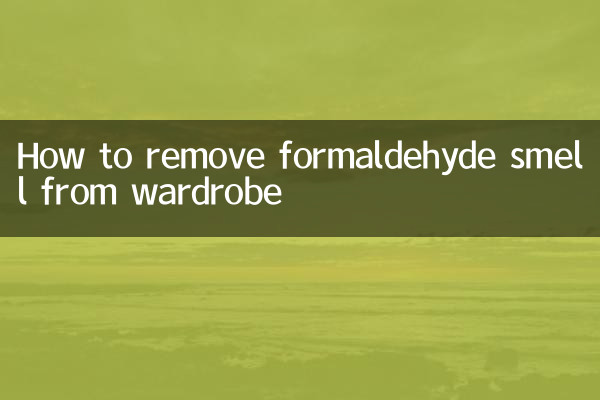How to remove formaldehyde smell from wardrobe
Formaldehyde is a common indoor air pollutant, especially in newly purchased wardrobes. Long-term exposure to formaldehyde can be harmful to human health, so it is important to remove the smell from your wardrobe. The following is a summary of popular methods and structured data on removing formaldehyde from wardrobes in the past 10 days across the Internet.
1. Sources and hazards of formaldehyde

Formaldehyde mainly comes from wardrobe boards, glue, paint and other materials. Long-term exposure to formaldehyde may cause eye irritation, throat discomfort, and even induce serious diseases such as leukemia. The following is detailed data on the hazards of formaldehyde:
| Formaldehyde concentration (mg/m³) | Effect on human body |
|---|---|
| 0.06-0.07 | mild asthma in children |
| 0.1-0.2 | Eye and throat discomfort in adults |
| 0.3-0.4 | Nausea, vomiting, chest tightness |
| 0.5 or more | May induce leukemia |
2. 5 effective ways to remove formaldehyde from wardrobes
The following are the most popular methods for removing formaldehyde that have been discussed on the Internet in the past 10 days:
| method | Principle | Operation steps | Effect |
|---|---|---|---|
| ventilation method | Using air movement to dilute formaldehyde | 1. Open the wardrobe door 2. Keep the room ventilated for 3-7 days | The short-term effect is obvious, but long-term persistence is required |
| Activated carbon adsorption | Physical adsorption of formaldehyde molecules | 1. Place 50g activated carbon per square meter 2. Change once a week | Medium effect, suitable for confined spaces |
| Green plant purification | Plant photosynthesis absorbs formaldehyde | 1. Place plants such as spider plants and pothos 2. Place 2-3 pots per 10 square meters | Auxiliary effect, slower to take effect |
| photocatalytic decomposition | Catalytic oxidation decomposition of formaldehyde | 1. Spray photocatalyst solution 2. Maintain lighting conditions | Long-term decomposition requires professional operation |
| air purifier | Filter and adsorb formaldehyde | 1. Choose a purifier with a high CADR value 2. Continuous operation for more than 8 hours | Fast and effective, but costly |
3. Formaldehyde release cycle of wardrobes made of different materials
According to the latest research data, the formaldehyde release cycles of wardrobes made of different materials vary greatly:
| Wardrobe material | Formaldehyde release cycle | Suggested treatment methods |
|---|---|---|
| density board | 3-15 years | Professional aldehyde removal service + long-term ventilation |
| multilayer solid wood | 1-3 years | Activated carbon + regular ventilation |
| solid wood | 3-6 months | Simply ventilate |
| metal/glass | Almost formaldehyde-free | No special treatment required |
4. Reviews of recent popular aldehyde removal products
Based on consumer feedback and expert reviews, the following are the aldehyde removal products that have performed well recently:
| Product name | Type | price range | User rating (5-point scale) |
|---|---|---|---|
| XX activated carbon | Adsorption type | 50-100 yuan | 4.5 |
| XX photocatalyst spray | decomposition class | 200-300 yuan | 4.2 |
| XX air purifier | Electrical appliances | 2000-3000 yuan | 4.8 |
| XX aldehyde removal gel | Chemistry | 100-150 yuan | 4.0 |
5. The golden combination of aldehyde removal recommended by experts
According to the advice of indoor environment experts, the most effective aldehyde removal solution is to use a combination of methods:
1.Early stage (1-2 weeks): Powerful ventilation + high temperature fumigation (natural high temperature in summer, heating assistance in winter)
2.Mid-term (1-3 months): Activated carbon adsorption + air purifier operates 24 hours a day
3.long term maintenance: Place green plants + regularly open windows for ventilation
Special reminder: Before using a new wardrobe, it is best to ask a professional organization to detect the formaldehyde concentration. If it exceeds 0.1mg/m³, it is recommended to suspend use.
6. Reminder of common misunderstandings
1.misperception: Thinking that no smell means no formaldehyde (formaldehyde may be odorless at low concentrations)
2.invalid method: Simply use grapefruit peels, tea leaves, etc. to cover the smell (cannot really remove formaldehyde)
3.over-reliance: Use only one method to remove aldehyde (a combination of methods should be used)
Through the above systematic methods and scientific data, I believe you can effectively remove the formaldehyde smell in the wardrobe and create a healthy and safe home environment.

check the details

check the details